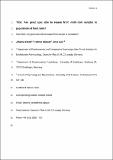Files in this item
Are great apes able to reason from multi-item samples to populations of food items?
Item metadata
| dc.contributor.author | Eckert, Johanna | |
| dc.contributor.author | Rakoczy, Hannes | |
| dc.contributor.author | Call, Josep | |
| dc.date.accessioned | 2018-09-05T23:35:26Z | |
| dc.date.available | 2018-09-05T23:35:26Z | |
| dc.date.issued | 2017-10 | |
| dc.identifier | 250846971 | |
| dc.identifier | aabfd222-1173-41f2-9705-ba2333143e60 | |
| dc.identifier | 85028946575 | |
| dc.identifier | 000411765900008 | |
| dc.identifier.citation | Eckert , J , Rakoczy , H & Call , J 2017 , ' Are great apes able to reason from multi-item samples to populations of food items? ' , American Journal of Primatology , vol. 79 , no. 10 , e22693 . https://doi.org/10.1002/ajp.22693 | en |
| dc.identifier.issn | 0275-2565 | |
| dc.identifier.other | ORCID: /0000-0002-8597-8336/work/37477996 | |
| dc.identifier.uri | https://hdl.handle.net/10023/15973 | |
| dc.description | The work reported in this paper was supported by a research grant of the German Science Foundation DFG (grant # RA 2155/3-1) to Hannes Rakoczy and Josep Call. | en |
| dc.description.abstract | Inductive learning from limited observations is a cognitive capacity of fundamental importance. In humans, it is underwritten by our intuitive statistics, the ability to draw systematic inferences from populations to randomly drawn samples and vice versa. According to recent research in cognitive development, human intuitive statistics develops early in infancy. Recent work in comparative psychology has produced first evidence for analogous cognitive capacities in great apes who flexibly drew inferences from populations to samples. In the present study, we investigated whether great apes (Pongo abelii, Pan troglodytes, Pan paniscus, Gorilla gorilla) also draw inductive inferences in the opposite direction, from samples to populations. In two experiments, apes saw an experimenter randomly drawing one multi-item sample from each of two populations of food items. The populations differed in their proportion of preferred to neutral items (24:6 vs. 6:24) but apes saw only the distribution of food items in the samples that reflected the distribution of the respective populations (e.g., 4:1 vs. 1:4). Based on this observation they were then allowed to choose between the two populations. Results show that apes seemed to make inferences from samples to populations and thus chose the population from which the more favorable (4:1) sample was drawn in Experiment 1. In this experiment, the more attractive sample not only contained proportionally but also absolutely more preferred food items than the less attractive sample. Experiment 2, however, revealed that when absolute and relative frequencies were disentangled, apes performed at chance level. Whether these limitations in apes’ performance reflect true limits of cognitive competence or merely performance limitations due to accessory task demands is still an open question. | |
| dc.format.extent | 455135 | |
| dc.language.iso | eng | |
| dc.relation.ispartof | American Journal of Primatology | en |
| dc.subject | Intuitive statistics | en |
| dc.subject | Probabilistic reasoning | en |
| dc.subject | Comparative cognition | en |
| dc.subject | Non-human primates | en |
| dc.subject | Numerical cognition | en |
| dc.subject | BF Psychology | en |
| dc.subject | DAS | en |
| dc.subject.lcc | BF | en |
| dc.title | Are great apes able to reason from multi-item samples to populations of food items? | en |
| dc.type | Journal article | en |
| dc.contributor.institution | University of St Andrews. School of Psychology and Neuroscience | en |
| dc.contributor.institution | University of St Andrews. Centre for Social Learning & Cognitive Evolution | en |
| dc.identifier.doi | 10.1002/ajp.22693 | |
| dc.description.status | Peer reviewed | en |
| dc.date.embargoedUntil | 2018-09-06 | |
| dc.identifier.url | http://onlinelibrary.wiley.com/doi/10.1002/ajp.22693/full#footer-support-info | en |
This item appears in the following Collection(s)
Items in the St Andrews Research Repository are protected by copyright, with all rights reserved, unless otherwise indicated.

